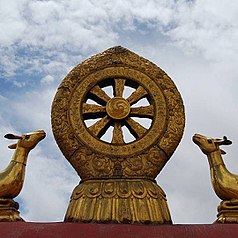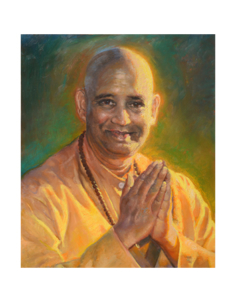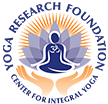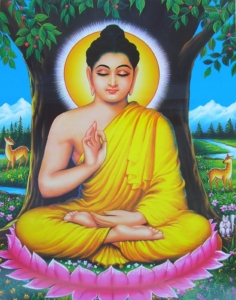Righteous Conduct and the Eight-fold Path of Lord Buddha
The story of Buddha is the story of spiritual movement that grows out of the perception of pain in everything, and finally seeks that stage where pain ceases in Nirvana. More than six centuries before the birth of Christ, there was a spiritual crisis in India – Vedic culture had begun to dwindle in the encircling gloom of illusion. Instead of sacrificing the latent beasts of anger and passion, people began to indulge in sacrificing innocent animals; instead of pursuing religion in its true spirit, they began to take recourse to crude forms of austerity, dry intellectual learning, and many hypocritical forms of piety. Violence, cruelty, selfishness, greed and passion began to dominate the minds of the masses. During such an atmosphere of the decline of virtue, there emerged the glorious light of the Spirit in the form of Buddha – a light that was meant to bring order in the world of disorder, to stop the decline of virtue, to dispel the forces of darkness and to promote the path of righteousness.
Buddha was born in the family of Shuddhodana, the King of Kapilavastu in Nepal. The King learned from the astrologers that the child may latter become a monk, but, if he is kept away from the manifestations of disease, old age, death and all conditions that cause sadness in human heart, he would become a great monarch. With this insight, all efforts were made to secure Siddhartha from the evidences of pain and misery; Siddhartha however, would soon become aware of an all-pervading pain that underlies human existence.
Though his father wanted to entangle him further by marrying him to princess Yashodhara, after the birth of his child, Siddhartha renounced the kingdom and entered into the dense forest of Bihar for seeking enlightenment. In the course of his search, he learnt various aspects of Yoga from various teachers, and engaged himself in the one-sided aspect of Yoga leading the extremes of penance and meditation. But, he soon realized the path of moderation, and having attained Nirvana, He became the
blessed teacher of the path that combined all the important features of the life’s movement to its perfection. The life of Buddha gives an insight into the life of Sadhana. His perfection is the ideal that humanity must continue to seek, wherein all cravings are destroyed, the mind is conquered, and the fetters of limitations are dropped from the infinite expansion of consciousness.
Righteous conduct is the foundation of Yogic movement. In Sanskrit terminology it is known as sadachar, but more popularly, it is known as dharma. In the practice of righteous conduct, having philosophical insight is very important, as a true understanding of righteousness will not develop in its absence. The goal of righteous conduct is to turn to the Divine Self. Therefore, true sadachar makes one healthy, integrated, and closer to God. In this direction, Lord Buddha outlined eight points in the practice of righteous conduct. He presented a picture of a sadachar in the form of his Eight-fold Path (Ashtanga Marga) which should be understood and followed.
 The first aspect of the Ashtanga Marga is called samyak dhrishti (right vision). It is the spiritual vision that serves as a foundation for the superstructure of righteous conduct. One must have a correct understanding of the goal and the Law of Karma. Correct understanding covers a vast area and is the topic of much philosophical study. Continue the study until you deeply and profoundly understand that the same Self dwells in all. All virtuous conduct must proceed from the deep conviction that allows you to view your whole body like a straw towards the service of righteousness, even to the point of risking your life. You can make the sacrifice because it is dharma that ultimately enables you to be liberated. Everyone must one day sacrifice his body so why not let it be sacrificed for dharma?
The first aspect of the Ashtanga Marga is called samyak dhrishti (right vision). It is the spiritual vision that serves as a foundation for the superstructure of righteous conduct. One must have a correct understanding of the goal and the Law of Karma. Correct understanding covers a vast area and is the topic of much philosophical study. Continue the study until you deeply and profoundly understand that the same Self dwells in all. All virtuous conduct must proceed from the deep conviction that allows you to view your whole body like a straw towards the service of righteousness, even to the point of risking your life. You can make the sacrifice because it is dharma that ultimately enables you to be liberated. Everyone must one day sacrifice his body so why not let it be sacrificed for dharma?
Dharma in every individual express is in its own unique manner. An aspirant living a balanced life day by day does not have anything spectacular show for it, although such a balanced life is in itself, a powerful dharma. Such dharma implies that you have learned the lessons of bearing insult and injury, adapting and adjusting, harmonizing with different personalities, waiting with patience to see things improve, and seeing that what you want is not forced on others, but rather presented to them with a gentle persuasion.
The next of the eight points is samyak samkalpa (right willing). Your will must be healthy. That is, do not will for things backed up by mental illusion. For example, if you develop hatred towards someone and mentally will for that person to suffer, it is a diseased desire that reduces your willpower. And then, in the course of time when the negative result develops, you suffer and pray to God with everything you can muster for alleviating your sufferings. Moreover, when you find that there is no response to your prayers, your mind turns to disbelief in the scriptures – “Why doesn’t God listen to me?” You must realize that by keeping negative samkalpas in your mind, you have created a negative situation – your prayer does work but you must not be impatient. Realizing the effect of your negative samkalpa, you must learn the art of purifying your will.
Samyak vacha (right speech) is the third point. Whatever you speak must be conditioned by a cultured insight, and at the same time, your words must not hurt others. You should be persuasive, yet gentle. Rough or violent talk can prevent a person from doing wrong, but only out of fear. It will not cure the root of the error. Words therefore, must be conditioned by correct understanding. The very purpose of speech should be to help others to see the truth. When a person speaks harshly however, the listener becomes offended and is unable to hear the words. He may also develop a feeling of dislike towards the speaker. Therefore, a spiritual aspirant must learn the art of persuasive speech blended with love and compassion.
The next is called samyak karmanta (right action). Whatever situation you are in, be guided by your balanced mind and reason, and have an insight into the Law of Karma. Be sure that good karmas proceed from your personality day by day. And just as the miser goes on counting his money every day and sees to it that it multiplies, so too you must be a miser with reference to spiritual samskaras (impressions in the unconscious). How many good karmas have you done? How can you do more? Good karmas are golden bricks that you have stored for the “heavenly world.” That is, good karmas performed with the right spirit and good samskaras generated in the unconscious, pave your way to Liberation.
The next point is samyak ajiva (right means of livelihood). The profession or career you take up should not involve unrighteous means, such as falsehood, violence, and the like. In spite of the fact there is much limitation in every means of livelihood, righteous men promote righteousness no matter what their profession – doctor, lawyer, judge, professor, shopkeeper or businessman. However, if possible, an aspirant should not take up jobs in butcher shops, gambling casinos or places of that nature. Such jobs are tamasic and rajasic and must be avoided. Do not be attracted towards them. There are thousands of people who will benefit and evolve through these professions but a spiritual aspirant is not one of them.
Spiritual values may not allow you to prosper quickly, but eventually you will prosper, and such prosperity will be complete. All spiritual movements require immense patience, and once people realize you are a righteous person – a person of your word, a person of character – you become successful. You succeed in your job, in earning money, and in winning the confidence of others.
The next is samyak vyayam (right endeavor). In your daily life, you must strive to perform righteous deeds, to master the mind and senses, to restrain negative thoughts, and to generate positive ones. You must constantly strive to integrate your personality and to progress spiritually. If you do not strive with vigilance, negative thoughts enter the mind and become intensified, thus restricting your spiritual movement. By constant effort however, you continue to dispel negative thoughts and in turn, entertain positive ones. This form of practice is vital to spiritual movement.
The following point is samyak smritti (right memory). This refers to the awakening of spiritual memories that lead to mystic advancement. The art of developing good impressions must be learned through Satsanga or good association, the practice of concentration and meditation, and through all the spiritual disciplines that allow you to develop a clear mind. During a clear and sattvic (pure) state of mind, you remember the subtle realities of your life. Those memories of meditations and experiences of Divine Love operating through your life become a powerful basis for spiritual advancement.
Most human beings on the other hand, are guided by confused memories that flow from a childhood experiences or past embodiments. As you practice meditation and samadhi (super-consciousness) however, you no longer view things through the complexes with which you grew up; you are able to view them with a detached mind. Led by a sattvic memory, you become a transformed personality and no longer refer to yourself as you were in the past – how are you struggled through childhood, or how you were bullied by someone in school. Rather the sattvic memory that has been developed is based on the experiences of spiritual sadhana.
Lastly is samyak samadhi (right samadhi) – attaining a meditative mind that flows towards the truth, towards the Divine Self. There are three stages in the practice of mental discipline: concentration, meditation and samadhi (intense meditation leading to super consciousness). An aspirant begins with the practice of concentration, and as sattwa or purity increases in the mind, he moves on to meditation and samadhi. He will then continue to ascend the various rungs of samadhi until there arises the intuitive vision that removes ignorance, the root-cause of all the miseries of life.
These eight points that constitute the Eight-fold Path of Buddha also serve as the standards for righteous conduct as presented in Raja yoga, the Bible, and other elevated spiritual teachings. They also point to the same goal: Nirvana or the Kingdom of Heaven or Self-realization.
Therefore sadachar or righteous conduct is not solely for an individual’s own good, but rather a movement that makes the individual vibrate with the universal plan of life. He vibrates with the Cosmic Mind and whatever he does, or thinks, serves as inspiration for the masses to follow. Without that movement, the world would enter into a rather chaotic state. The chronic defects of society can thus be attacked by this one simple, yet powerful method, which inspires people to understand the nature of the Self, integrates the personality, and promotes a healthy, balanced, and complex-free mind. May you all receive the blessings of Lord Buddha, the Enlightened One!
 May God Bless You! OM Tat Sat!
May God Bless You! OM Tat Sat!


